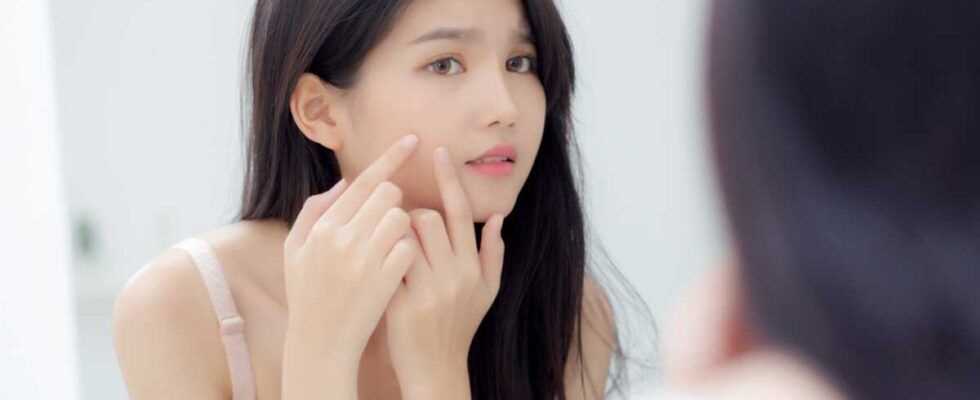Microcyst in the face: what is it exactly?
Micro-cyst on the face: definition. The microcyst in the face (which is also called “closed comedone”) results from two factors: hyperstimulation of the sebaceous glands (these glands which produce sebum, under the skin) and the presence of a “plug” at the level of the skin. excretory duct. Result: there is an accumulation of sebum under the skin and this sebum cannot be evacuated – we therefore observe the appearance of a pimple.
Microcyst in the face: what are the signs? The microcyst in the face forms a “white point” (a small raised “ball”) under the skin. If it is not the site of inflammation (that is to say: if we have not tried to pierce it, to scratch it …) it is neither red nor hot, nor painful to touch.
Warning ! Do not confuse the microcyst on the face (or “closed comedo”) with the black point (which is also called “open comedo”): “ the black point or open comedo constitutes the evolution of the microcyst in the face: if the pressure of the sebum under the skin is very important, the pimple opens on the surface through a pore, explains Dr. Isabelle Gallay, dermatologist. The keratin which is mixed with the sebum then oxidizes on contact with the air and the pimple takes on a blackish appearance – this is the black point. “
And also… Do not confuse the microcyst on the face with the sebaceous cyst (or “epidermal cyst”) which, if it results from the same mechanism, is larger and can form anywhere on the body (face, back, mucous membranes). …). The dermoid cyst, on the other hand, is located deeper, while the lipoma is a soft, mobile nodule made up of fatty tissue.
Microcyst in the face: what are the treatments?
Why do you have to remove a micro-cyst from your face? Beyond the unsightly appearance of the micro-cyst on the face, there is a real health risk: “ the content of microcysts is a mixture of sebum, keratin and microorganisms. The microcyst is prone to ignite when this product does not evacuate through the pores on the surface of the skin because these become blocked due to too thick and / or too much production, and too much development of certain germs which produce inflammatory substances by feeding on the keratin “specifies Dr. Isabelle Gallay.
Micro-cyst in the face: what treatment? “ To remove a micro-cyst from the face, it is necessary to make a micro-incision: this surgical procedure is commonly performed by the dermatologist in his office, without anesthesia. “explains the specialist.
In the event of retentional acne (that is to say: with a lot of micro-cysts on the face), the dermatologist may suggest a cleansing of the skin involving dilation of the pores. ” This gesture can also be performed at the beautician “notes Dr. Isabelle Gallay.
Micro-cyst on the face: can they be removed at home? ” It is to be avoided, the dermatologist immediately warns us. Indeed: at home, we tend to want to “pierce” our micro-cysts in the face, therefore to “force” by pressing on the skin. The problem, besides the fact that this gesture does not allow the complete evacuation of the micro-cyst, is that this behavior can lead to local inflammation: the micro-cyst (s) then become red and painful, they swell, they feel hot to the touch … which only makes the situation worse. “
Not to mention the risk of bacterial infection, ” for example: by Staphylococcus aureus if you are a healthy carrier of this bacteria, notes Dr. Gallay. This superinfection can have serious consequences if the micro-cyst is located near the eyes. “.
Microcyst in the face: 3 natural remedies to try
Warning ! The natural remedies mentioned below do not replace a consultation with a dermatologist.
- Naturopathy. Green clay has the property of absorbing excess sebum: in the event of a micro-cyst on the face, we do not hesitate to regularly make a green clay mask – to leave on overnight.
- Aromatherapy. Tea tree essential oil (Melaleuca alternifolia Maiden.) is bactericidal: formidable against retentional acne, it prevents superinfection of micro-cysts in the face. Apply 1 pure drop of tea tree essential oil to each pimple, morning and evening after washing your face, every day for 3 weeks. This essential oil is prohibited in pregnant women as well as in people suffering from epilepsy.
- Homeopathy. In case of micro-cyst with inflammation, take Hepar Sulfur 5 CH, 3 granules morning, noon and evening. Hepar Sulfur is “the” homeopathic remedy for acne, abscesses, boils …
Thanks to the Dr. Isabelle Gallay, dermatologist in Dijon (21) and Vice President of SNDV (National Syndicate of Dermatology Venerology).
Read also :
⋙ Allergy button: what to do in case of allergic urticaria?
⋙ Stress button: how to recognize it and get rid of it?
⋙ Pimple on the forehead: how to get rid of it?
